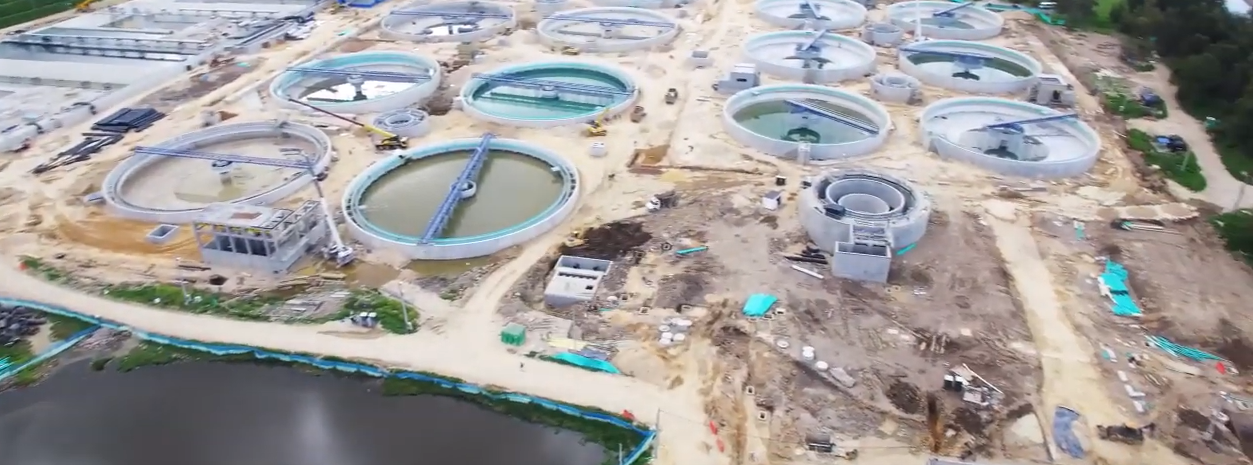 Waste treatment plant Colombia
Waste treatment plant Colombia
Also available in: Español
Editor’s Note: Efficiently investing in wastewater and other sanitation infrastructure is crucial to achieve public health benefits, improve the environment, and enhance quality of life. Safely managed water, sanitation and hygiene (WASH) services are an essential part of preventing disease and protecting human health during infectious disease outbreaks, including the current COVID-19 pandemic. Learn more: www.worldbank.org/wastetoresource
The Bogotá River is located in the Cundinamarca Department of Colombia. It starts at an elevation of 3,400 meters in Villa Pinzon Municipality, and flows 380 km before joining the Magdalena River at an elevation of 280 meters in Girardot Municipality. The Basin covers 6,000 km2 and includes 45 municipalities and the Bogotá Capital District.
The Basin provides hydropower generation and water for irrigation in the upper basin and receives wastewater discharges from nearly 10 million people in the lower basin. In this area, 26 percent of Colombia’s total economic activity is generated.
The Bogotá River (Río Bogotá) used to play an important role, back in the 40s, in providing the residents of Colombia’s largest city with essential water supply and sanitation (WSS) services. But since 1950s, wastewater discharges from domestic and industrial sources, as well as from urban runoff and the dumping of solid waste, severely polluted the river over the years. As a result, the river stopped being used as a source of water supply for the population of Bogotá and turned into a source of pollution, health issues and environmental degradation. Moreover, sediment contamination and torrential rains contributed to massive floods in 2010-2011 that caused displacements, increased environmental pollution and casualties.
Improving the sustainability, quality and resilience of wastewater services in Bogota is essential to ensure that the city’s inhabitants can rely on resources stemming from wastewater treatment for years to come. Though this is no small feat, designing and implementing an array of impactful initiatives that build on circular economy principles can help set the stage and make this goal more attainable. Some of these principles have been incorporated in the cleanup process of the Rio Bogota.
Principle one: river basin planning
As a first step, the Government of Colombia through the Corporacion Autonoma Regional Regional de Cundinamarca (CAR) – the regulatory authority in the region – and with technical support from the World Bank, led the development of a basin management plan focused on flood control, wastewater management and water quality restoration.
Developing the basin management plan, however, was especially complex given the multifaceted approach that had to be undertaken and the different stakeholders that make decisions related to water use in the basin. Numerous steps were incorporated to ensure that it was comprehensive and left no stone unturned. These steps include building partnerships, characterizing the watershed, defining management goals, formulating potential solutions, developing and implementing a watershed and M&E plans. Plenty of management alternatives were simulated and finally combined into an investment schedule to attain the river restauration and flood control objectives sought out for the basin.
This is where collaboration between the World Bank and various stakeholders in Bogota came most in handy. The World Bank helped finance the Rio Bogota Megaproject with two concrete items: upgrading the El Salitre wastewater treatment plant and the development of flood control structural and non-structural measures along 68 kilometers of the river.
Principle two: thinking about energy efficiency and resource recovery
As a second step, the Government of Colombia, with the support of the World Bank, redesigned the El Salitre wastewater treatment Plant to account for an expansion in its capacity so that 7 m3/s of wastewater can be treated and cover 30 percent of the wastewater generated by the City of Bogota. The new design of the plant included an energy recovery provision to generate a significant part of the plant’s consumption needs and a disinfection treatment process that will allow further treatment of up to 14 m3/s for the reuse of wastewater for agricultural purposes in a future stage. Also contributing to the circular economy is the production of 132 tons/day (dry basis) of biosolids that could be readily used for agricultural purposes. Once it’s fully operational, the El Salitre wastewater plant will be the largest treatment plant in Colombia.
Collectively, the implementation of these two principles contributed to the increased resilience and sustainability of Bogota’s wastewater assets and services. This will allow more of Bogota’s residents in the short and long-term to reap the benefits that come along with necessary sanitation improvements and upgrades. With the implementation of proper circular economy principles, these benefits will not merely be a flash in the pan, but rather ones that will leave long-lasting impressions and results for years to come.



Join the Conversation